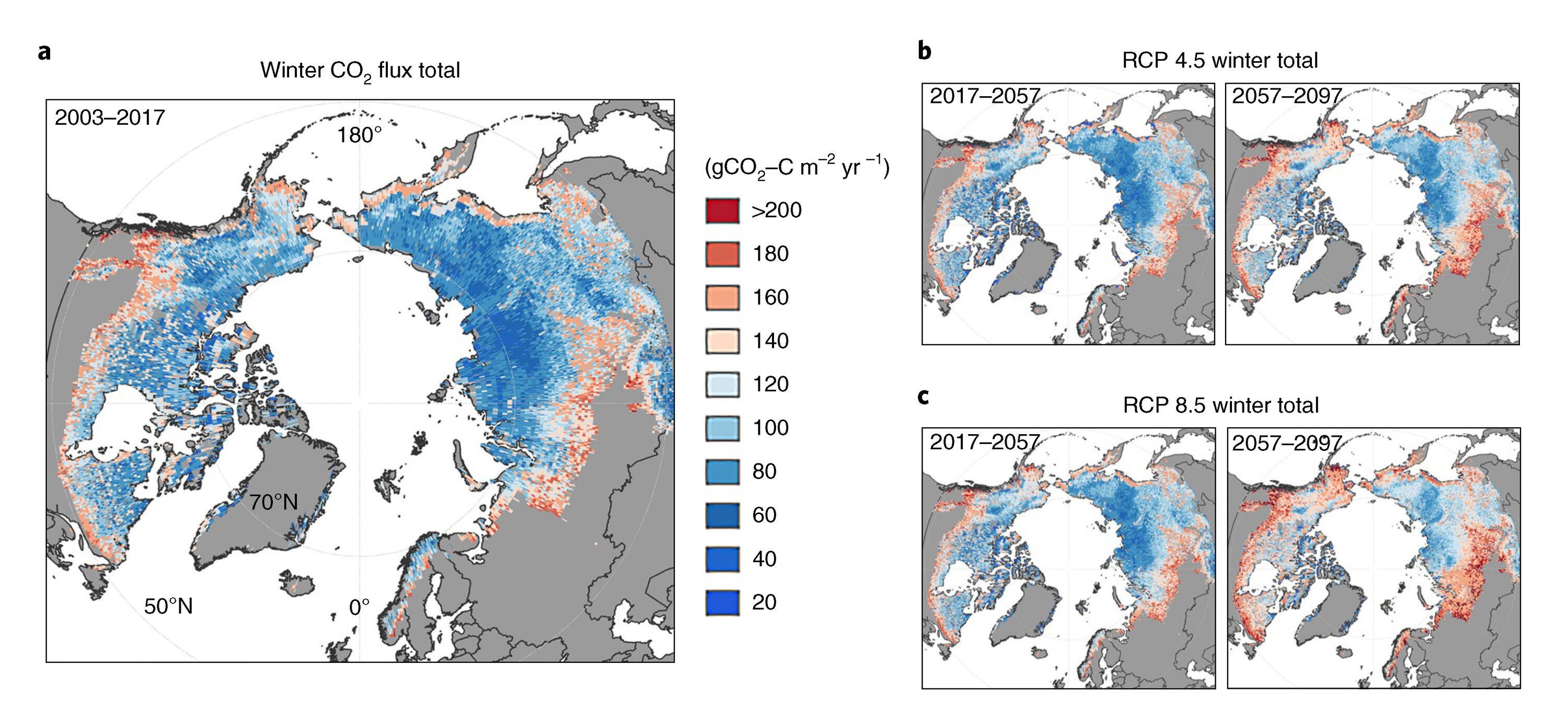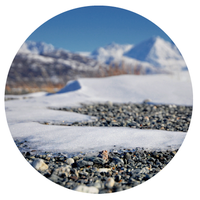Introduction
The Arctic is warming more than twice as fast as the rest of the planet, with the greatest warming occurring during the non-growing season (NGS) (October to April). Warming during the NGS may substantially alter the carbon balance of the Arctic because microbial respiration — which can occur in unfrozen microsites surrounding soil particles or in deeper unfrozen soil layers — responds positively to warming even at sub-zero temperatures. Respiration during the NGS has been recognized as an important component of Arctic carbon budgets for more than two decades, yet in situ and remotely-sensed measurements are still relatively sparse. As a result, the sign and magnitude of current and future Arctic carbon balances remain highly uncertain.
Atmospheric carbon dioxide (CO2) enhancements for Alaska and site-level studies from Alaskan tundra demonstrate that NGS emissions can shift Arctic tundra regions from an annual carbon sink to a source. Yet, it is still unknown if this is a trend across the whole Arctic. Previous studies have linked NGS respiration to soil temperature, vegetation, snow depth, and substrate availability. Inter-site variability in rates and drivers, however, has limited our understanding of the relative influence of these drivers, trajectories, and patterns of respiration across the Arctic.
In this study, we draw upon a newly synthesized, in situ, CO2 flux dataset of the NGS to 1) examine drivers of respiration, 2) estimate current CO2 emissions for the northern permafrost region, and 3) project CO2 emissions under future climate scenarios to quantify future Arctic carbon balances.
Methodology
A team of international researchers and collaborators compiled a dataset of in situ NGS CO2 emissions and potential driving variables from 66 published and 21 unpublished studies, covering 104 sites and 152 sampling locations in boreal and tundra landcover classes. We also extracted CO2 data from incubations of permafrost-region soils. This was the first time the influence of soil respiration during the NGS on CO2 emissions has been compared in this way, and on such a large scale.
Using the newly synthesized dataset, we examined patterns and processes driving NGS CO2 emissions. We then scaled fluxes to the northern permafrost region using a boosted regression tree machine-learning model based on hypothesized NGS flux drivers, which were extracted from publications or geospatial datasets. Finally, we estimated future NGS CO2 fluxes, using meteorological and carbon cycle drivers, under “mitigation” and “business-as-usual” scenarios.
Outcomes
Air and soil temperatures have the strongest influence on pan-Arctic NGS CO2 emissions, followed by gross primary productivity and landcover. There are also positive relationships between NGS flux and leaf area index, enhanced vegetation index, and per cent soil organic carbon, all pointing to the key role of plant functional characteristics and substrate availability on NGS CO2 emissions.
Together with NGS temperature, gross primary productivity has been increasing across the Arctic. This positive relationship between gross primary productivity and NGS CO2 emissions suggests that increased CO2 uptake during the growing season may be offset, to some degree, by CO2 emissions during the NGS. An important driver of NGS respiration is the availability of unfrozen water, which is a function of soil temperature and texture, as finer-textured soils contain more unfrozen water than coarse soils for a given sub-zero temperature. Although there are no direct in situ measurements of unfrozen water in this dataset, indirect measurements confirm its importance.
NGS CO2 emissions are detected at soil temperatures as low as -20 degrees Celsius. Respiration has been detected at similar temperatures in lab incubations demonstrating that microbial respiration can persist in unfrozen microsites at sub-zero temperatures. However, diffusion of stored CO2 produced during the growing season and early fall may have driven some of the emissions measured at extremely cold temperatures.
Extracted flux data was scaled to the northern permafrost domain to estimate regional CO2 fluxes. We estimated that 1,662 teragrams of carbon (TgC) were released during the NGS from 2003-2017 (Figure 1a). There were no significant temporal trends in pan-Arctic CO2 fluxes during this period, which is not surprising as there were also no significant trends during this interval in NGS air or soil temperatures. Our flux estimates are two times higher than previous estimates derived from in situ measurements. Although relatively coarse model resolutions do not capture small-scale processes that influence NGS fluxes, we estimate here that the pan-Arctic permafrost region is currently an annual carbon source.

FIGURE 1: Pan-Arctic winter CO2 emissions under current and future climate scenarios. a) Average annual winter (October–April) CO2 emissions estimated for the permafrost region for the baseline years 2003–2017. b,c) Cumulative winter CO2 fluxes under RCP 4.5 (b) and RCP 8.5 (c) scenarios over an 80-year period (2017–2057 and 2057–2097). Fluxes are reported on an annual basis.
We compared our upscaled NGS flux estimate to net ecosystem exchange (NEE) outputs from five process-based terrestrial models and FluxCom, a global machine-learning NEE product. Our permafrost region estimate of NGS CO2 flux was generally higher but within the range of CO2 emissions from these models, which ranged from a low of 377 TgC NGS-1 for FluxCom, and from 503 to 1,301 TgC NGS-1 for the process-based models.
There were significant increases in NGS CO2 emissions under both climate scenarios. By 2100, NSG CO2 emissions are projected to increase 17 per cent for the mitigation scenario (Figure 1b) and 41 per cent for the business-as-usual scenario (Figure 1c). Increased NGS CO2 emissions are largely driven by changes in soil and air temperatures.
Conclusions
This study’s NGS CO2 emissions estimate is two times higher than a previously reported regional estimate, shifting the pan-Arctic region to a carbon source on an annual basis. This finding demonstrates that NGS respiration is a substantial part of the Arctic ecosystem carbon balance, and highlights the importance of the NGS for regional carbon assessments and, importantly, of the role of climate change mitigation in limiting carbon losses from the Arctic. Although future NGS CO2 losses are expected to increase, this positive feedback on global climate could be mitigated with a reduction of global anthropogenic greenhouse gas emissions.
We recommend increased spatial and temporal coverage of in situ NGS measurements and the development of remote sensors that can perform during periods of low to no light, which is a key constraint in efforts to monitor changes in Arctic carbon cycling.
Natali, S.M., Watts, J.D., Potter, S., Rogers, B.M., Ludwig, S.M., Selbmann, A.-K., Sullivan, P.F., Abbott, B.W., Arndt, K.A., Birch, L., Björkman, M.P., Bloom, A.A., Celis, G., Christensen, T.R., Christiansen, C.T., Commane, R., Cooper, E.J., Crill, P., Czimczik, C., Davydov, S., Du, J., Egan, J.E., Elberling, B., Euskirchen, E.S., Friborg, T., Genet, H., Göckede, M., Goodrich, J.P., Grogan, P., Helbig, M., Jafarov, E.E., Jastrow, J.D., Kalhori, A.A.M., Kim, Y., Kimball, J., Kutzbach, L., Lara, M.J., Larsen, K.S., Loranty, M.M., Lund, M., Lupascu, M., Madani, N., Malhotra, A., McFarland, J., McGuire, A.D., Michelsen, A., Minions, C., Oechel5, W.C., Olefeldt, D., Parmentier, F.-J.W., Pirk, N., Poulter, B., Quinton, W., Rezanezhad, F., Risk, D., Sachs, T., Schaefer, K., Schmidt, N.M., Schuur, E.A.G., Semenchuk, P.R., Shaver, G., Sonnentag, O., Starr, G., Treat, C.C., Waldrop, M.P., Wang, Y., Welker, J., Wille, C., Xu, X., Zhang, Z., Zhuang, Q. & Zona, D (2019). Winter CO2 losses shift the Arctic to a carbon source under current and future climates. Nature Climate Change, 9, 852–857. doi.org/10.1038/s41558-019-0592-8
Photo: Arctic Permafrost by Dr. Homa Kheyrollah Pour.
For more information about WaterResearch, contact Julie Grant.











